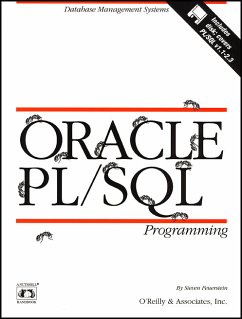Oracle is the most popular database management system in use today, and PL/SQL plays a pivotal role in current and projected Oracle products and applications. PL/SQL is a relatively new programming language providing procedural extensions to the SQL relational database language and to an ever-growing number of Oracle development tools, including SQL*Plus, Oracle Forms, Oracle Graphics, Oracle Reports, and Oracle Developer 2000 (formerly the Cooperative Development Environment (CDE)). It offers a myriad of data types, and such features as cursors, loops, conditional and sequential control statements, exception handlers, records, tables, and constructs for developing modular code (functions, procedures, and packages). Originally a rather limited tool, PL/SQL is now a mature and effective language for developers.
As more and more Oracle customers move from the mainframe to client- server configurations, PL/SQL is becoming ever more crucial. It provides the foundation for the code used to distribute processing and transactions across the network.
PL/SQL allows the developer to:
- Design powerful and easy-to-use GUI interfaces in products like Oracle Forms and Oracle Graphics
- Build complex reports and long-running batch processes
- Implement critical business rules in database triggers and stored procedures
Although PL/SQL is very important to Oracle customers, it has not received the attention -- by Oracle Corporation and outside vendors and authors -- that it deserves. The only book previously available on PL/SQL is the overly concise Oracle reference manual. Training courses tend to focus on the flashy side of the new GUI tools and ignore the more complicated PL/SQL programming that is so vital to production applications.
Oracle PL/SQL Programming fills a huge gap in the Oracle market. The book provides developers with a single, comprehensive guide to building applications with PL/SQL -- and building them the right way. It's packed with strategies, code architectures, tips, techniques, and fully realized code. The book comes with a disk containing many examples of PL/SQL programs that readers can use immediately or as starting points for further development.
Oracle PL/SQL Programming is divided into six parts:
Part I introduces PL/SQL, its many versions, the environments in which it operates, PL/SQL language fundamentals, and effective coding style
Part II describes basic PL/SQL statements for variables, cursors, conditional and sequential control, loops, exception handling, records, and tables
Part III describes all of the built-in (predefined) PL/SQL functions and procedures -- string, date, number, and miscellaneous as well as the built-in packages that come with PL/SQL
Part IV describes how to modularize your PL/SQL programs using blocks, procedures, functions, and packages.
Part V describes how to debug PL/SQL programs and manage code in the database. It also contains a summary of tips for using PL/SQL most effectively.
Part VI contains appendices summarizing the contents of the disk and the calling of stored procedures from Version 1.1.
As more and more Oracle customers move from the mainframe to client- server configurations, PL/SQL is becoming ever more crucial. It provides the foundation for the code used to distribute processing and transactions across the network.
PL/SQL allows the developer to:
- Design powerful and easy-to-use GUI interfaces in products like Oracle Forms and Oracle Graphics
- Build complex reports and long-running batch processes
- Implement critical business rules in database triggers and stored procedures
Although PL/SQL is very important to Oracle customers, it has not received the attention -- by Oracle Corporation and outside vendors and authors -- that it deserves. The only book previously available on PL/SQL is the overly concise Oracle reference manual. Training courses tend to focus on the flashy side of the new GUI tools and ignore the more complicated PL/SQL programming that is so vital to production applications.
Oracle PL/SQL Programming fills a huge gap in the Oracle market. The book provides developers with a single, comprehensive guide to building applications with PL/SQL -- and building them the right way. It's packed with strategies, code architectures, tips, techniques, and fully realized code. The book comes with a disk containing many examples of PL/SQL programs that readers can use immediately or as starting points for further development.
Oracle PL/SQL Programming is divided into six parts:
Part I introduces PL/SQL, its many versions, the environments in which it operates, PL/SQL language fundamentals, and effective coding style
Part II describes basic PL/SQL statements for variables, cursors, conditional and sequential control, loops, exception handling, records, and tables
Part III describes all of the built-in (predefined) PL/SQL functions and procedures -- string, date, number, and miscellaneous as well as the built-in packages that come with PL/SQL
Part IV describes how to modularize your PL/SQL programs using blocks, procedures, functions, and packages.
Part V describes how to debug PL/SQL programs and manage code in the database. It also contains a summary of tips for using PL/SQL most effectively.
Part VI contains appendices summarizing the contents of the disk and the calling of stored procedures from Version 1.1.

